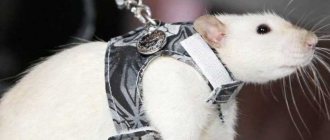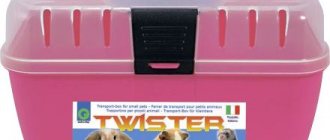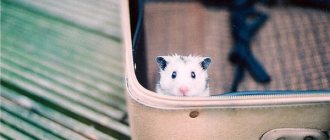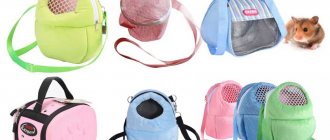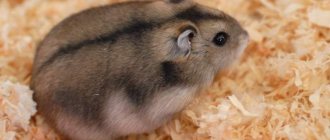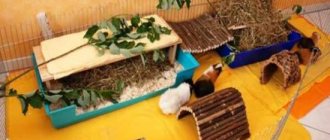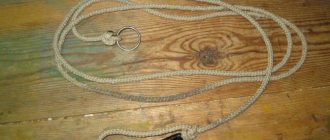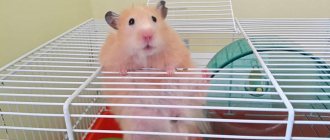Types of leashes
Pet stores offer a wide selection:
- Collar with leash.
This type of collar specifically for hamsters is used infrequently, only if the pet is a large breed. Usually it is worn as a decoration, since walking with such a collar is problematic, because the pet can slip out of it at any moment.
- Harness for a hamster.
This type of collar is more reliable and is best suited for walking. A loop made of leather or fabric material secures the body and legs and is attached to the back. This design will definitely not allow the animal to wriggle out. The harness is put on loosely, so that you can stick your finger into the gap between the loop and the hamster’s body. The collar should not be worn tightly or loosely, otherwise the hamster can be injured or create conditions for escape.
- Harness vest.
A vest harness is much safer and more reliable. It is believed that the hamster is more comfortable in it. Please note that the harness and collar must be securely fastened, otherwise the hamster may be lost somewhere.
- Walking ball.
Another worthy option for walking your pet. The walking ball is not a leash, but at the same time it is quite comfortable to use. The material of the device is usually plastic, the ball is dotted with special holes. This option is best suited for walking dzhungarikas or other small breeds, so the hamster will definitely not run away. Larger breeds of rodents will feel uncomfortable, so their use does not make sense.
Harness or collar
Nowadays there is a lot of advice that it is better to walk your dog using a harness. I both agree and disagree. Observing the behavior of the dog tells me that both options should be used in different circumstances.
For me, in everyday use with Madame Leroy - a collar, a harness for traveling in public transport and making grand entrances in unfamiliar places.
I noticed that the dog’s behavior changes depending on what it is wearing. In a harness she behaves more freely, much more confidently and... more sassy.
This is understandable, minimum load on the body. This is an observation of Madame Leroy. The collar removes excessive freedom from our relationship (master - dog), which suits us.
Plus the dog loves water, she is ready to climb in and lie in any puddle. It is possible to take such baths in a harness, but the likelihood of irritation on the dog’s skin is very high.
That's why I AM FOR a collar for daily walks.
How to make a harness with your own hands
If the pet store does not have accessories of this type or you could not find a suitable one, then you can easily make it yourself. No special pattern is needed. All you need to do is carefully examine the harness in the photo and accurately measure your pet. Taking all this into account, sewing a collar yourself will not be difficult.
A few tips you might find useful:
- Organize a strong and reliable fastening.
- The material should be thick or leather.
- The harness should be bright, for greater practicality.
- The size should not be large or small.
A homemade harness is different from a store-bought one; it is much more convenient, because it is tailored individually to your animal.
After the harness, all that remains is to pick up the leash. Any strong rope to which you need to attach a carabiner is suitable for this.
It is better to wear a collar at home. If the hamster does not give in, he needs to be distracted with tasty food. The pet will immediately forget about the leash when it finds itself on the grass. He will have more important things to do. If this does not happen and the animal tries to escape, most likely the harness is causing discomfort to the hamster. If you carefully choose and choose the right leash, walks can make your pet a little happier.
Benefits of walking
Veterinarians are divided on the issue of walking so many small animals. Some people think this is a bad idea, citing the high likelihood of the pig suffering psychological and psychological damage. Others counter with the factor of the benefits of fresh air for domestic rodents. Recently, popularity has shifted to supporters of active walks with guinea pigs - but with reservations.
Walking your pet in the average yard may not be a good idea. There is so much noise and traffic around that the pig can get psychological trauma. There is an even greater danger from other animals - street cats and dogs, who see such easy prey. They can do something irreparable. Therefore, you can only walk in quiet and peaceful places where danger is minimized.
At the same time, walks in the fresh air, the opportunity to run on the grass and chew on twigs to the fullest are very useful for guinea pigs. They may be domestic animals, but they are active and inquisitive animals. Their mood noticeably improves, which gives the owner positive emotions.
The benefits of walking a guinea pig include the following:
- These furry creatures are prone to obesity, despite their miniature size. Walking does not threaten them with this disease.
- Pigs are social animals; being confined to their own home can, oddly enough, depress them. Introducing such variety will help avoid stress in your mumps and its unpleasant consequences.
- A harness for a guinea pig is necessary - a guarantee that the animal will not disappear without a trace under the nearest bush.
If there are children in the family, a walk with your favorite pet will be a real adventure for them. Of course, you need to explain to them the rules of such a promenade in order to avoid incidents.
A harness for guinea pigs is the most difficult thing in preparing for walks with your pet. The fact is that a collar is strictly contraindicated for them: the neck muscles of rodents are extremely fragile. One careless movement and a fracture will occur. Therefore, harnesses are selected for them that wrap around the body, safely distributing pressure.
The easiest way to get a harness for your guinea pig is to go to a pet store. If the product you are interested in is not available, you cannot buy goods for other animals - even if the seller assures you otherwise.
For a guinea pig, design is not important - convenience is important to him. There are several acceptable harness options for them:
- A vest attached to the bottom is the best option for them in terms of convenience. It does not restrict movement and even protects from damage. There is only one downside - if the pig grows up or changes a lot of things, the clothes will not fit her.
- A figure eight harness is an original solution for walking your pet. Reliable fastening and practicality. A vest, for example, needs to be washed sometimes - guinea pigs are mobile, but a figure-eight harness - much less often.
- If the pet is still growing, a harness in the form of stripes is best suited for it - they are adjustable and fit tightly around the animal's body.
It is worth remembering, however, that during a walk the pet’s comfort is a priority. A finger should fit freely between the harness and the rodent's body; in no case should the fabric fit tightly. They have delicate skin, so only moderately spacious, but strong harness.
Corn filler
Although this filler for hamsters is the last in order, it is the first in properties. Corn litter, being better than shavings, is suitable for any hamster. The only negative is the high price. It doesn’t need to be changed often because it copes well with odors. You need to lay a thin layer of bedding in the cage and the unpleasant odors will disappear. Suitable for allergy sufferers who cannot tolerate wood dust. Corn filler does not contain it.
Perfect for those who cannot figure out which bedding will be most comfortable for their pet. Hamsters enjoy rummaging and digging in corn litter. Suitable for almost any breed.
Although you can do without bedding, with it the rodent will be warm and comfortable, and it will be easier for the owner to clean up after the pet. You need to carefully choose the litter and monitor the hamster to see how much he likes it.
How to make a leash for a guinea pig with your own hands
It is not necessary to buy a device for walking with your pet; you can make a leash for your guinea pig yourself. There are several options - you can refresh the selection tips by reading the beginning of the article.
Harness with jumper on the back
A practical option that uses straps - can be adjusted to the size of the animal. To work, you will need strips of belts or thick fabric - straps from an old backpack are ideal. And two buckles with a fixing pin - to secure the volume.
List of additional accessories:
- Metal half ring.
- Carbine.
- Thick sewing needle - a regular one will not cope with the thickness of the material.
- Strong threads.
You also need to buy a leash in advance - it can be easily attached to the jumper of the finished harness. If it is not possible to purchase a buckle, it can be replaced with a fastex fastener - they are used on backpack straps. The adjustment options will be reduced, but the pet will definitely not get hurt.
The procedure for making a harness with your own hands:
- Cut strips of prepared fabric, leaving 4–5 cm for seams and fastening.
- Make a collar from a shorter strip, connect them and sew on a buckle.
- Make holes at the other end that will allow you to adjust the size of the collar.
- Similarly, make a second collar of larger volume.
- Connect both elements symmetrically with a strip of fabric, and fasten a half ring in the place of the jumper with the front collar.
- Attach a carabiner to it and attach it to the purchased leash.
This is the easiest and most convenient way to create a harness for a guinea pig. It is only important to use soft fabric to make your pet comfortable.
Vest from an old sleeve
For this method, you need an old jacket or sweater, from which you can cut a sleeve of a certain length - measure from the neck to 2/3 of the length of the body. The fabric may look sloppy at the edges, so it needs to be processed; it is recommended to crochet the woolen material along the rim.
The main parameter is the circumference of the pig’s neck and chest; you need to add a few centimeters to this measurement. The fastener must be sewn to one edge, then hooking the stopper in series to the tapes. This will allow you to adjust the tension force. Then sew on the second trident, connecting the result with a jumper. The edges of the material need to be folded and sewn, after attaching a half ring. The length of the jumper should not be less than the distance from the neck to the bottom of the animal's chest.
You can purchase a leash, or you can make it yourself: for this you need a long, dense piece of fabric, on one side of which there is a hole for the hand. On the other hand, it needs to be secured to the half-ring with a carabiner. The harness for the guinea pig is ready.
Djungarian hamster: care
Hamsters are an optimal alternative to large pets - dogs, cats, birds. Small in size, they fit into compact cages that can be placed anywhere in the room. They do not need to be brushed, walked or bathed daily.
Some animal lovers may have a question: what are the benefits of a hamster? You can’t pet him, you can’t run with him (unless he escapes from the cage and you have to organize a hunt for the cunning pet), he doesn’t purr and doesn’t know how to whine cheerfully.
Some people are fascinated by the energy and activity of hamsters, the specifics of their pastime and actions. They can be comical, especially when they try to carry more in their cheek pouches than they weigh themselves.
Photo: pixabay.com: UGC
However, there are categories of people for whom even an ordinary hamster is a fairly large animal, which also has a specific aroma and multiplies exponentially. Therefore, they are looking for a miniature pet that would not emit an odor and could live without a mate. Djungarian hamsters have these qualities.
Dzhungariks are inhabitants of the steppes of Central Asia. In their natural environment, you will meet them in Eastern Kazakhstan, Khakassia and Western Siberia.
These rodents are small in size: they weigh up to 40 g and grow up to 5 cm. They have a characteristic feature - a dark stripe of fur that runs from the head to a short tail.
A photo of Djungarian hamsters demonstrates the richness of their colors. Nurseries will offer rodents: gray-blue, pearl (white) or light brown (tangerine) in color.
Photo: Wikipedia: UGC
The Djungarian hamster is an active nocturnal animal. Consider this nuance when buying a pet. If you have sensitive hearing, then refuse such a purchase. Otherwise, this cute rodent is easy to keep at home.
How to care for a Djungarian hamster? This question worries those who are getting such a pet for the first time. Here are the basic rules that we recommend following in order to create comfortable conditions for the animal, provide it with proper physical activity, nutrition and care for the dwarfs:
Which cage to choose?
Despite their small size, dwarfs are very active and love to run. Therefore, buy your pet a two- to three-story cage with iron or plastic bars (they can easily chew through wooden ones).
The cage must have a strong and reliable latch, otherwise cunning travelers will easily open the doors and escape. In this case, the rodents will have to be caught in special traps and returned to their place.
Alternatively, use a large aquarium with high walls. Never put your hamster in a jar or narrow container. The problem with glassware is the lack of air circulation. Because of this, pathogenic bacteria develop and the hamsters get sick.
How to arrange a cage?
Equip the cage with a house, a wheel and pipes. Rodents of this breed vitally need to move a lot: climb passages, spin a running wheel. If there is no such equipment, the Djungarians will quickly gain weight, because they do not know what to eat in moderation, and they will develop obesity, which will lead to death.
In addition, install a ceramic feeder in the cage (if there are two rodents, then double so that they do not fight), screw the drinking bowl to the bars of the cage.
Djungarians are clean animals; they carefully monitor the cleanliness of their fur. If it gets dirty, then put a bath in the cage with sand for chinchillas or regular sand. The hamster enjoys shopping in it.
Photo: pixabay.com: UGC
Where to put the cage?
Place the permanent habitat of the dwarfs so that it receives diffused sunlight. Place the cage away from drafts and the heating system.
How to cover the cage?
Some owners put cotton wool or torn paper (newspapers) on the bottom of the cage. This is not rational, not practical and harmful to the animal. Hamsters will have to change their bedding frequently, so buying cotton wool will be a major expense. Newspapers and papers may contain printing or printer ink. It is toxic to rodents.
Buy cellulose or corn sawdust from a pet store. They are environmentally friendly, inexpensive and easy to recycle: such litter is thrown into the sewer, in trash containers or buried in the garden.
To make a comfortable rookery (hamsters bury themselves in sawdust during the day), spread a small layer of bedding. If you need to make a den, the Djungarians will rake sawdust into a pile exactly as much as needed. Napkins are also suitable for these purposes. Their clever sneaks drag them into a house where they build a nest.
Photo: pixabay.com: UGC
How often should you deep clean your cage?
Clean dzhungarikas arrange a toilet in one of the corners of the cage. Therefore, the owners’ task is to clean this place every day.
But it cannot be confused with animal bins. If you regularly throw away the supplies of grains and fruits that a rodent makes, it will become stressed and may get sick. Remove only the storage area where food has spoiled and an unpleasant odor has appeared.
Change the rest of the bedding once a week and do general cleaning: wash the bottom of the cage, accessories, toy, bowl, drinking bowl with a sponge, laundry soap and hot water. For especially “fragrant” places, use a vinegar solution (1 tablespoon per 1 glass of water). After wiping with this composition, wash the item being treated with clean water.
It is not worth cleaning the hamster’s “apartment” more often, because for them the moments of replacing sawdust are extremely stressful. While tidying up, move the hamster into a smaller cage.
Djungarians do not live long - 2-3 years. Therefore, to maintain health and prevent diseases, they need proper living conditions and special care. Then the cheerful fidgets will delight you with fun games and interesting ideas.
Accessories for walking
There are many accessories that are used when walking. In specialized stores you can purchase:
- leash with collar;
- harness (made of loops or in the form of a vest);
- walking ball.
In a walking ball, the hamster will be able to safely move around the entire territory.
For street walks, you will have to choose between a harness or a regular leash with a collar.
Vests, which are available in different colors, a large number of models from various materials, are especially popular. It protects the animal from dirt and precipitation, securely fixing its body.
Recommendations for making a harness
To make a leash for a hamster with your own hands, you will have to familiarize yourself with the basics of sewing; such an accessory for walking should be bright, beautiful and comfortable for your pet. It is necessary to correctly take the measurements, transfer them to the fabric and realize your idea using hand sewing skills or using a sewing machine.
When deciding to make a leash with your own hands, you should consider some nuances:
- Use durable fabric and secure fastenings.
- Give preference to bright colors. If the hamster runs away while walking, you can quickly find it.
- The harness for a hamster should be made with a reserve (especially for young pets).
What are there
The main models are:
- harness;
- harness-vest;
- leash with collar;
- walking ball.
A regular harness is shaped like a figure eight, fastened in the middle with a leather pad to which the leash is attached. One figure eight ring is threaded under the pet’s tummy, and the other is fixed in front of the front paws, covering the neck.
If such a harness is larger or smaller than the pet, then it will be uncomfortable for him to breathe, or the hamster will fall out of it, so the harness mount is movable so that it can be adjusted to the size of the pet.
The size of the harness is checked with your little finger: if you can put a finger between the fastening and the back, then this is the optimal size for the hamster.
The harness-vest resembles a vest with a leash attached at the top. The model is comfortable, does not interfere with movement, and the animal will not fall out.
A leash with a collar is worn in the same way as for other animals. This leash is only suitable for large breed hamsters. This is the least convenient model. Safety measures are especially important in it: prevent it from falling out of the collar, do not make sudden jerks, etc.
A walking ball is a ball made of polymers or plastic with breathing holes and a side lid. Having placed the hamster in the ball, you just need to close the lid and let it onto the floor or onto the platform.
This way the animal will be safe from contact with cats or dogs, and nothing will interfere with its movements. A ball is a better option for training muscles and providing physical activity than a wheel in a cage.
How to make a vest with a leash
The pattern is cut out and applied to the fabric, and its outline is traced with a pencil or soap. The workpiece is cut and the edges of the fabric are stitched. The next step is to install the fasteners:
- It is necessary to put the future harness on the pet, wrapping it around its body. It is necessary to mark the place where the fastening rings will be sewn on the animal’s belly.
- The ring is sewn to the product from the back side. It will be the attachment point for a carabiner with a leash.
If desired, the product can be decorated with embroidery or fabric stripes. Walking in the cold season requires insulation. A DIY hamster harness is made using two layers of fabric. Between them should be stitched (sintepon, down, etc.). Such an accessory will be not only comfortable, but also warm.
The main advantage of making your own accessories is their low cost. For ready-made goods, you will have to pay a round sum in the store. Making them yourself is much cheaper and easier.
To make a harness for a hamster you only need fabric, thread with a needle and fasteners. You can make your own leash for hamsters from a rope, an old belt, etc. Provided you prepare all the necessary materials, it will take only 10-15 minutes to make a collar.
When is a harness appropriate:
You have a small dog with a fragile build. For her, the harness is additional protection and support for her miniature body.
Your dog is a sled dog and loves to run in a harness. For example, Bonchik loved to run in front of the bicycle. The harness distributes effort well and in this case the leash gets tangled less.
You are going somewhere with your dog on public transport. It is easier to hold the dog by the harness; there is less chance that it will twist and jump out of the harness.
Your dog has a massive body and a not too large head. Simply put, your dog is fat. These cunning creatures can simply emerge from the collar. We have seen this more than once. You grab her by the collar, and she seems to pull her head in and the collar simply slides off the folds of her neck, remaining in your hands. Then catch the dog!

